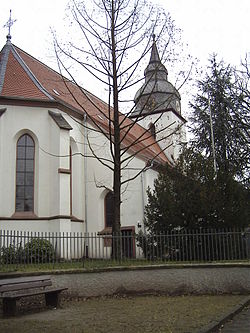Arheilgen | |
|---|---|
 Evangelical Lutheran Church | |
| Coordinates: 49°54′39″N8°39′26″E / 49.91083°N 8.65722°E | |
| Country | Germany |
| State | Hesse |
| Admin. region | Darmstadt |
| District | Urban district |
| City | Darmstadt |
| Area | |
• Total | 11.27 km2 (4.35 sq mi) |
| Elevation | 129 m (423 ft) |
| Population (2019-12-31) [1] | |
• Total | 17,927 |
| • Density | 1,600/km2 (4,100/sq mi) |
| Time zone | UTC+01:00 (CET) |
| • Summer (DST) | UTC+02:00 (CEST) |
| Postal codes | 64291 |
| Dialling codes | 06151 |
| Website | www |
Arheilgen is a district in the north of the city of Darmstadt in Hesse, Germany, incorporated in 1937. Arheilgen borders the Darmstadt district of Wixhausen to the North, to the West is the town of Weiterstadt, to the East is the Darmstadt district of Kranichstein and to the South is the city center of Darmstadt. [2]




